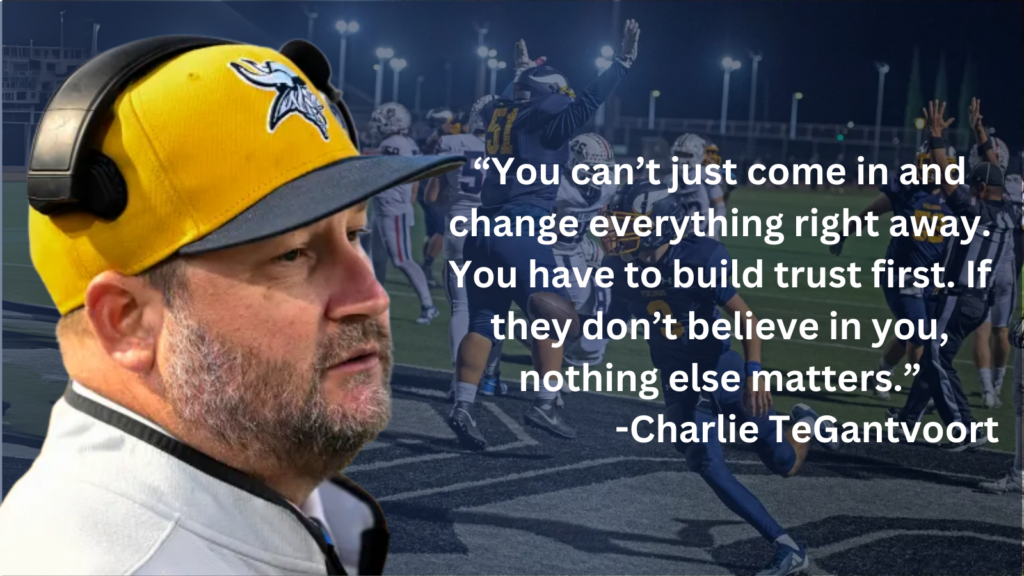
A losing team doesn’t turn into a contender overnight. There’s no magic formula, no secret playbook. It takes time, relentless energy, and a clear plan. Coach Charlie TeGantvoort knows this firsthand. He has stepped into programs buried under years of losing seasons and transformed them into playoff teams. The process isn’t easy, but it is possible—with the right approach.
“You can’t just come in and change everything right away,” TeGantvoort said. “You have to build trust first. If they don’t believe in you, nothing else matters.”

Step 1: Build Trust Before Anything Else
Trust has to come first, before schemes, before weight room programs, and before anything football-related. Players, coaches, and the community must believe in the vision. That starts with showing up every day with energy and consistency.
Trust isn’t built in team meetings—it’s built in the everyday moments. Taking time to talk to a struggling player, checking in on grades, being present in the hallways, the weight room, and every practice. Those moments matter more than any speech about a fresh start.
TeGantvoort understood that a losing team isn’t just physically beaten down—it’s also mentally defeated. He made it clear to his players that the past didn’t define them, but they had to be willing to work to change the future.
“I told them, ‘I don’t care what happened before. That’s over. We’re starting fresh, and we’re gonna build something together,’” he said. That message set the tone—no dwelling on the past—just a focus on what could be built moving forward.
Step 2: Set the Standard—And Hold Everyone to It
Once trust is established, the next step is establishing clear, non-negotiable standards. That doesn’t just mean showing up on time or wearing the right gear. It means setting expectations for effort, attitude, and discipline and refusing to compromise on them.
Some players will resist. Some will test the boundaries. That’s normal. What matters is sticking to the standard and proving that it applies to everyone. TeGantvoort saw this firsthand when he took over his program. Players were used to cutting corners, and old habits didn’t change overnight.
“We had kids who had been cutting corners for years,” he said. “When they saw we weren’t backing down, that’s when things started to change.” The moment players realized accountability wasn’t optional, the culture started to shift.
Accountability has to be consistent. If a star player skips a workout, there has to be a consequence. If a backup offensive lineman shows up late, the response has to be the same. Players don’t buy in when they see inconsistency. They buy in when they see fairness and structure.
Step 3: Create Small Wins to Build Confidence
Losing teams don’t believe they can win—because they haven’t. That’s why early victories, no matter how small, are critical. It might mean a dominant weight room session, a well-executed practice, or a competitive showing against a stronger team.
TeGantvoort knew his players needed a reason to believe in themselves. Instead of immediately pitting his team against powerhouses, he scheduled winnable games to build confidence. This wasn’t about taking an easy route—it was about giving his players a real chance to see progress.
“If you go 0-5 every year to start the season, those kids check out,” he explained. “We had to give them something to believe in.” That belief starts small—a hard-fought win, a close game against a tough opponent, a moment where players realize they’re capable of more than they thought.
Confidence grows through repetition. When players experience success—even in practice—they start expecting it. A team that expects to win plays differently than a team that hopes to win.
Step 4: Strengthen the Culture—Every Single Day
Culture isn’t a speech. It’s the work, accountability, and attitude players bring daily. Coaches have to reinforce it constantly. That means calling out effort, recognizing leadership, and making sure players hold each other accountable—not just the coaching staff.
It’s also about getting the community involved. Parents, teachers, and administrators need to feel connected to the program. When they do, the support system for players gets stronger, and the standard set in the locker room extends beyond football.
Winning programs don’t just operate on game days. They operate in the weight room, in the classroom, and in the way players carry themselves every day. When culture is strong, players start policing themselves. It’s no longer just the coaches demanding effort—it’s teammates pushing each other to do more.
Step 5: Playoff Teams Expect to Win—And Prove It
The final shift from a struggling program to a contender comes when the team fully buys into the work, the culture, and the expectations. They don’t hope to win when Friday nights arrive—they expect it. They walk onto the field knowing they’ve put in the work.
By the time the playoffs arrive, the foundation has already been built. The turnaround isn’t complete until players believe they belong on that stage. The first time they make a deep run, it’s a breakthrough. The second time, it’s the standard.
The Turnaround Starts Now
Every coach who steps into a struggling program faces the same choice: make excuses or get to work. The process isn’t easy. It takes trust, accountability, confidence, and daily commitment. However, the rewards are real for coaches willing to put in the effort.
A playoff run doesn’t start in November; it begins when a new standard is set. And as Coach TeGantvoort has proven, no program is too far gone to turn around.
Need Resources to Turn Your Program Around?
CoachTube gives you on-demand access to courses from elite coaches, covering strategy, culture, and player development. Learn from the best and start building your winning program today at CoachTube.com


